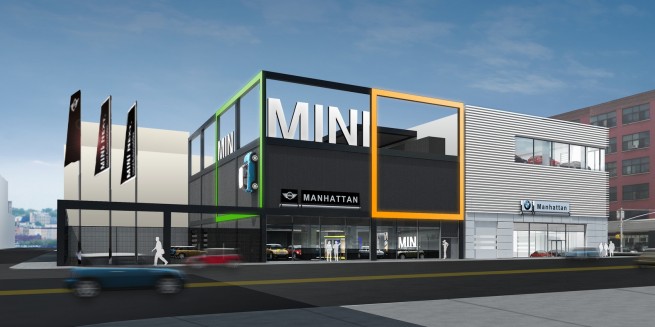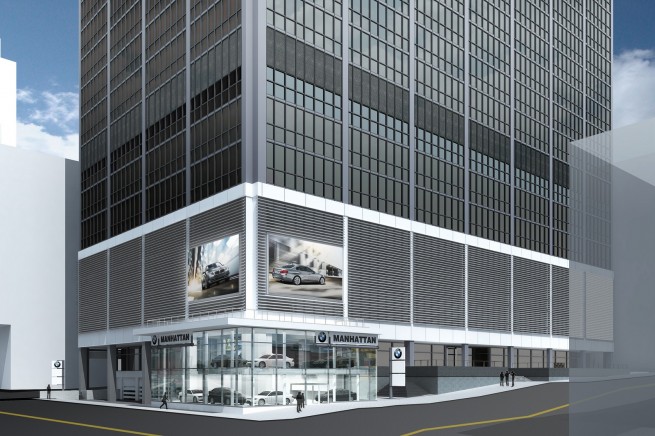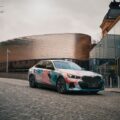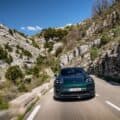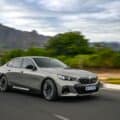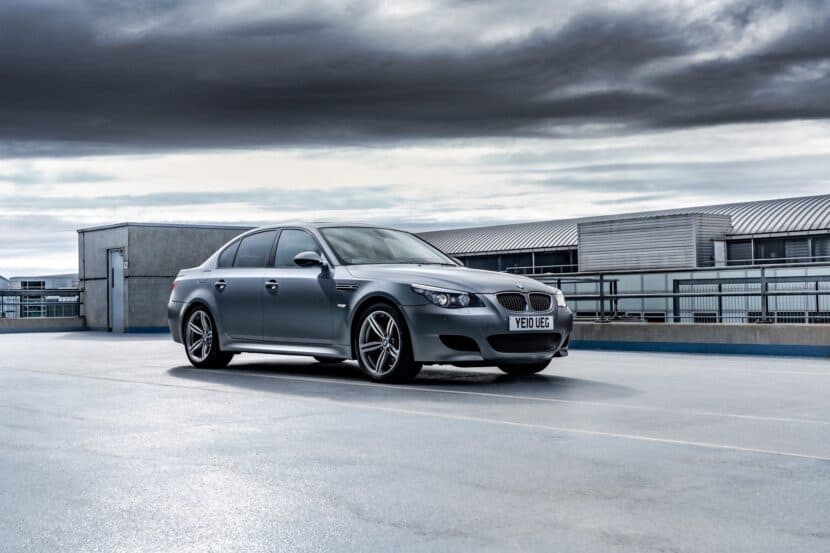The dealership renovations deepen the company’s commitment to the future of mobility in one of the world’s most heavily populated urban centers. BMW of Manhattan will remain at 555 W. 57th Street and will continue to sell and service BMW automobiles and sport activity vehicles, BMW Motorcycles, and is intended to be a BMW i Center when the company begins to introduce the first two vehicles of this new brand in 2013, the i3 and i8.
The creation of a standalone MINI of Manhattan dealership and a BMW Certified Pre-Owned sales center in the Chapman Building at 11th Avenue and 56th Street will begin at the same time. Construction of BMW of Manhattan is expected to be completed by the end of 2012 and MINI of Manhattan will be completed by the end of 2011.
“New York is an important market for BMW, and as America’s foremost megacity, it’s a great incubator to develop vehicles, facilities and services for a sustainable mobility future,” said Peter Miles Executive Vice President Operations BMW NA. “This renovation and new construction represents more than just a fiscal investment and also underscores the BMW Group’s commitment in America and in New York City.”
These announcements come only two weeks after the company announced BMW i Ventures, another pillar in its commitment to urban mobility and another commitment to New York City as a center of mobility technology and innovation.
BMW i Ventures will focus on premium mobility services – meaning that it will also look for solutions that are not exclusively related to automobiles. The fund’s first investment was in MyCityWay, a set of location-based apps for urban navigation that provides users with information on public transportation, parking availability and local entertainment.
When work begins to completely renovate the BMW of Manhattan dealership and establish an all new MINI facility and center for BMW Certified Pre-Owned vehicles on 11th Avenue at 56th Street, it will highlight another investment in New York City.
Upon completion, both facilities will be truly sustainable major urban center dealerships. They will be LEED Certified in keeping with BMW’s commitment to sustainability in all of its activities. Specific design elements will include:
- Specially-designed louvers on the exterior of the building to reduce heat loads while maximizing daylight;
- Installation of solar panels on the roof of the MINI building;
- High efficiency fluorescent, metal halide and LED light fixtures;
- New high-efficiency mechanical equipment including heat exchangers to capture heat from exhaust air;
- Low-flow plumbing fixtures;
- Regionally sourced materials that have a substantial recycled material content;
- Implementation of waste recycling practices during and after construction.
Both buildings will feature a full complement of electric vehicle charging stations and be capable of handling all customer and service needs of alternative powered vehicles, including hybrids and full-electric vehicles. All service reception and vehicle flow through the buildings will be optimized to minimize the number of times a car must be moved between arrival and delivery.
With the consolidation of MINI sales and service under one roof, the brand will now have a very visible presence on 11th Avenue. The exterior will feature MINI’s recognizable rectangular grid architectural style and announce the brand’s presence with the use of colorful frames and MINI logo on a black background.
- Originally constructed in 1973, the 20-story building has been home to BMW of Manhattan since 1998.
- BMW of Manhattan occupies a total of 228,000 square feet in the 1,001,360 square foot building.
- SL Green functions as the building’s landlord.
- The Chapman Building:
- The Chapman Building is located at 11th Avenue and 56th Street and will be home to the new MINI of Manhattan.
- The MINI of Manhattan dealership will occupy 69,000 square feet
- Construction Manager: Bovis Lend Lease LMB, INC- John Ford (Vice President)
- Architects/Engineers: HLW International, LLP: Walter Zupancich AIA (Senior Partner)
- Contractor: Hunter Roberts Construction Group- D, Andrew D¡¦Amico (General Contractor)
- Expected date of BMW of Manhattan completion: end of 2012
- Expected date of MINI Manhattan completion: end of 2011
- Exterior fin system provides a reduction in solar heat gain which results in an overall estimated 12% savings on energy usage of cooling equipment.
- Variable air volume systems reduce air flow when cooling load demands are low, providing energy savings.
- Air conditioning equipment uses a more ozone safe gas.
- Use of high efficiency air cooled split DX systems replace standard efficiency units which lowers operating costs.
- Carbon monoxide detection system allows for a reduction of exhaust air when CO levels are low and saves energy on fan motor usage.
- Use of MERV 13 filters on AC units, which allows for a cleaner air environment.
- Outstanding community connectivity and access to public transportation.
- 35% reduction in water use as a result of low-flow plumbing fixtures.
- In construction, at least 75% of construction waste will be diverted from deposit in landfills.
- An Indoor Air Quality Management Plan will be enforced during construction, reducing indoor air quality problems due to particulates and dust entering the HVAC equipment.
- Air testing performed before occupancy ensures minimum levels of airborne chemicals.
- Specified low-emitting paints, adhesives, sealants, flooring and systems furniture reduce off-gassing and indoor air quality problems.
- Minimum of 10% recycled content in all materials used in construction.
- At least 50% of all wood will be certified in accordance with the Forest Stewardship Council (FSC).
- The lighting design meets a 10% reduction of the current energy code¡¦s maximum allowed power. Meeting this prerequisite enables 555 West 57th Street to qualify as a LEED certified building.
- Lighting automatically shuts off through the use of occupancy sensors and time clock.
- Occupants control their individual lighting via task lighting.
- In order to meet LEEDs required energy reduction, energy efficient lamps or energy efficient lamp/ballast combinations are used where applicable, allowing energy consumption not be grossly over BMW’s and IESNA recommended lighting levels.
- Air conditioning equipment replaced with one that uses a more ozone safe gas.
- Use of heat recovery system for garage spaces, which allows for 5% savings in both winter and summer seasons.
- Use of high efficiency air cooled split DX systems replace standard efficiency units which lowers operating costs.
- Motor power consumption is reduced by using premium efficiency variable speed drive motors on rooftop units.
- Carbon monoxide detection system allows for a reduction of exhaust air when CO levels are low and saves energy on fan motor usage.
- Use of MERV 13 filters on AC units, allows for a cleaner air environment.
- Outstanding community connectivity and access to public transportation.
- 35% water reduction with the use of low-flow plumbing fixtures.
- In construction, at least 75% of construction waste will be diverted from deposit in landfills.
- An Indoor Air Quality Management Plan will be enforced during construction, reducing indoor air quality problems due to particulates and dust entering the HVAC equipment.
- Air testing performed before occupancy ensures minimum levels of airborne chemicals.
- Specified low-emitting paints, adhesives, sealants, flooring and systems furniture reduce off-gassing and indoor air quality problems.
- Minimum of 10% recycled content in all materials used in construction.
- At least 50% of all wood will be certified in accordance with the Forest Stewardship Council (FSC).
- Upgraded windows will improve the energy savings by 5%.
- The roof will be insulated to enhance the energy performance of the building by an additional 5%.
- Total projected energy savings from the various energy savings methods is 25% .
- Lighting automatically shuts off through the use of occupancy sensors and time clock.
- Occupants control their individual lighting via task lighting.
- In order to meet LEED¡¦s required energy reduction, energy efficient lamps or energy efficient lamp/ballast combinations are used where applicable, allowing energy consumption not be grossly over BMW’s and IESNA recommended lighting levels.
[Source: BMW ]


